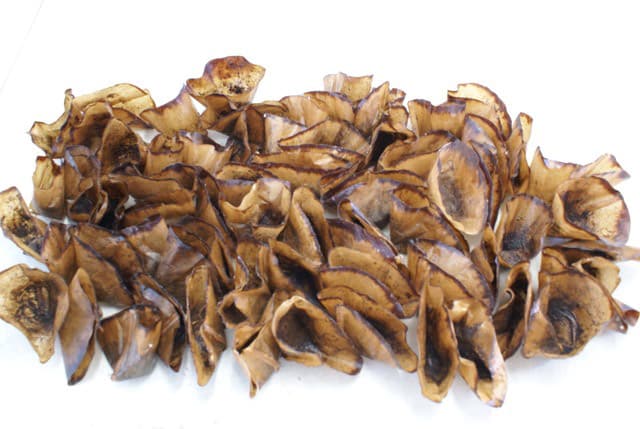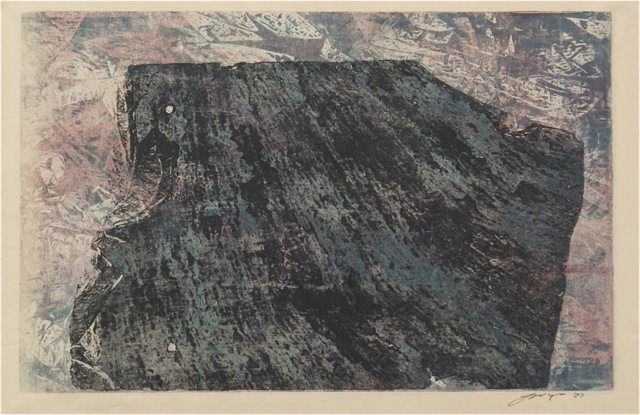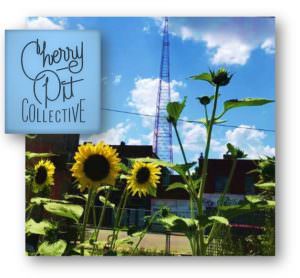Many moons ago, on a few occasions, we were lucky to have Chuck Lathrop visit Paper Connection. Back then, Chuck Lathrop lived in nearby Massachusetts and was part of the Monotype Guild of New England. Chuck exposed us to his brave approach to print on ANY surface, resulting in cutting-edge, bold and abstract prints, and we exposed him to traditional, Japanese, fine art papers or washi.
A few years ago, Chuck left our area to start his own studio in the sunny Southwest. Let’s talk to Chuck and find out his opinion on paper, and the situation with his own handmade paper with dryer lint! Chuck is never shied away from trying new surfaces; coffee filters, and yes, even dryer lint paper.

PCI: Please tell us about what you do.
CL: Over the last 35 years my work has included printmaking, painting, mixed-media drawings and objects. The landscape has always had a huge influence on my work. At first it was through direct observation or photos, but today I work from within relying on memory, impressions, andemotion to create abstractions. Automatic mark-making is a huge part of my work as well.
PCI: Who has inspired you?
CL: My artistic influences are varied and too numerous to cite individually. Paul Cezanne and Robert Motherwell standout because my introduction to them coincided with huge changes in my style and motif. Today, there are many contemporary artists I draw inspiration from.
PCI: What attracts you to working with paper? What do you like best about working with it?
CL: Paper is probably one of the most versatile substrates available to artists and I have enjoyed pushing it to its limits.

mixed media drawing on Kozo
PCI: How did you hear about our company?
CL: I was introduced to Paper Connection International through the Monotype Guild of New England when Lauren Pearlman invited MGNE members to come to PCI’s office (showroom/warehouse) to talk about Japanese paper.
PCI: How much knowledge did you have about Japanese papers before using ours? How did we help?
CL: Until my introduction to PCI I had only used Western paper and my knowledge of Japanese paper was very limited. What my association with Lauren and PCI did for me was to expose me to a lot more possibilities regarding paper.
PCI: What papers do you use of ours and for what process? What did you like about those papers that aided in your creative and/or technical process?
CL: Kumohada Unryushi, (now a limited edition paper), and the various weights of Kozo are the ones I use the most frequently. I use the Kozo for monotypes and woodcuts. The Kumohada is utilized for collagraphs and painting. Some of the work on these papers I have mounted to panel and used as a basis for encaustic work. (Please see image below of When the Rhythm Sections Floats I Float Too, encaustic on reduction woodcut on panel).

PCI: We are learning much about how our papers react to the encaustic process, and we’d love more of your feedback as we are novices to the application.

encaustic on reduction woodcut on panel
PCI: We’re reminded of your visit and how laundry lint inspired you?
CL: As I remember it I was learning how make paper with scraps of museum board, something of which I generally have a quite a bit of in the studio. In my research I ran across a reference to someone using dryer lint. Made sense to me since some Western papers were made from cotton rags hence term “rag paper”. I collected a bunch of lint from the dryer and one day when I was creating paper from museum board I threw some of the lint into the mix towards the end of the day’s session. Consequently the first sheet had a little paper pulp which yielded a light blue-gray and the last sheets had no paper pulp and came out a dark blue-gray. Though I still have some sheets of the paper (both from museum board and lint), I created at the time (the late 1990’s), and still work with it on occasion, I found the paper was weak and easily tore when I didn’t want it to tear. Given that I now live the Southwest and water supply is always an issue, especially during the current drought we are in, and the fact that any kind of paper making takes a large amount of water, I probably won’t be making any more paper.
PCI: We commend your awareness and responsible action. What is your experience as far as the strength of Japanese papers versus Western papers?
CL: I prefer Western paper when I create paintings and mixed drawings, but for printmaking I prefer the Japanese papers. The Japanese papers don’t hold up well with my painting techniques and tend to fur-up when I draw on them. On the other hand I appreciate the quality of the Japanese papers when I’m making prints because there is a beautiful difference on how they receive the ink regardless of the strength. I don’t think Eastern paper is necessarily stronger than Western paper. A paper’s strength is largely dependent on the length of its fibers and what it is made of. I suspect some of the Eastern papers maybe stronger, but on the other hand, I would also guess some of the Western papers might be stronger. Other issues in this discussion are the questions: What will the paper used for? Will it be dampened or soaked? How absorbent is the paper dry or wet?
PCI: Those are all very good questions that one should ask before purchasing paper. Our famous bonus question: If you could have a conversation with any artist present or past, who would it be? And would you talk about paper?
CL: Yikes! There are so many I would like to have a conversation with that if I had the chance I would gather them around a table, if a large enough one could be found, just to talk about art.
PCI: We’ll provide the drinks!
For more on Chuck Lathrop, please visit his website: www.chucklathrop.com. Chuck has recently established an online journal: www.nmartreview.com. We enjoyed the discussion, “On Serious Art.”
An upcoming show at the Downtown Contemporary Gallery, in Albuquerque, NM, will feature Chuck along with other printmakers. The show opens May 30th. If you are in the Albuquerque area then please go!


